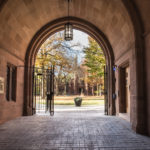Every form of education, in its content and method of instruction, implies a philosophical anthropology—a certain understanding of what it means to be human. Over the last year, the explosion of online instruction has taken in great swaths of every level and kind of education. We distinguish “online” (or “distance” or “remote”) learning not from “offline” (or “proximate” or “present”) learning but from “in-person” education. This is a telling phrase. What view of the human person does online instruction tend to reinforce? Why does our language tell us that “in-person” education is necessarily not online?
Online instruction encourages the idea that education is a transfer of information from one receptacle to another. This is all well and good, if you believe that the educable part of a person is the mind, the mind comes to know by acquiring data, and the mind is radically divorced from the body. Online instruction reinforces, or at least does nothing to oppose, an all-too-prevalent view of the dis-integrated person: the human being as a mind lodged in a body from which it is alienated, stuck in a physical world that can, and should, be remade according to our sovereign will.
Call it gnosticism, the heresy according to which “human beings are non-bodily persons inhabiting non-personal bodies.” As Robert P. George has written, gnostic anthropology holds that “the material or bodily is inferior—if not a prison to escape, certainly a mere instrument to be manipulated to serve the goals of the ‘person,’ understood as the spirit or mind or psyche. The self is a spiritual or mental substance; the body, its merely material vehicle.”
An extreme but informative depiction of an online gnostic education appeared in The Matrix (1999), when Neo is plugged into a computer, spends ten hours having martial arts skills uploaded to his brain, and opens his eyes to gasp, “I know kung-fu.” The screen that monitors Neo’s progress displays a human brain filling up, like a computer’s progress bar graphic. It flickers as each discrete, quantifiable learning objective is achieved. The technician overseeing the upload, impressed by Neo’s capacity (which is to say, the receptivity of an empty vessel to being filled), remarks: “He’s a machine.” Morpheus, diligent professor that he is, immediately evaluates the student’s newly acquired skills: “Show me!”
Start your day with Public Discourse
Sign up and get our daily essays sent straight to your inbox.No one today thinks that “instruction” as data-upload is possible (at least not yet). But a similar deformation of education is found in the imperative—inevitably voiced by administrators or accreditors rather than faculty—to break every course in every discipline into quantifiable and assessable units of “content” that can be easily delivered, digested, and assessed.
What view of the human person does online instruction tend to reinforce? Why does our language tell us that 'in-person' education is necessarily not online?
Our Psychosomatic Unities, Ourselves
The Matrix’s gnostic anthropology is disturbingly ascendant today. As Titus Techera has observed, The Matrix was “strangely prophetic” in showing how “discontent with the world” leads to “discontent with the body,” and how its vision of “radical liberation” does not end with “liberation of bodies” but entails “liberation from the human body itself.” Transgenderism is only the most extreme manifestation of this trend. It is acutely manifested in the deformations of eros, that most physical of the spiritual passions, in Gen Z, and in the transhumanist desire to upload ourselves to eternal life in the Cloud.
Yet the common phrase “in-person” indicates that we all know at some level that the gnostics are wrong about human nature. We yearn to experience reality as the integrated persons we are, and as we are taught by the varieties of anti-gnosticism that have formed the mainstream of our anthropology going back to the religious and philosophical roots of our civilization. The anti-Gnostic position holds that the human person is a substantial unity of body and soul. This truth is revealed by Scripture: “the Lord God fashioned the human, humus from the soil, and blew into his nostrils the breath of life, and the human became a living creature” (Gen. 2:7). A human being is an integral whole, made up of the same material stuff as the earth and the lower animals, animated or brought to life by the divine breath, something higher and immaterial. This vision of the human person in particular and reality in general is essential to Christianity, from Creation to the Incarnation to the Resurrection. Dante learns that even the souls in heaven evince a “desire for their dead bodies,” for “the resurrection of the body and the life of the world to come.”
These truths about nature and human nature were discovered independently by the Greek philosophers. This is especially clear in Aristotelian hylomorphism, according to which every substantial thing is a unity of matter (hule) and form (morphē). Even Plato—who puts speeches and myths in the mouth of Socrates that seem to advance some sort of gnostic dualism—testified to the importance of educating body as well as soul, muscle as well as mind, in his classic formulations of musical and gymnastic education in the Republic and Laws. The religious and philosophical authorities of our tradition clarify and justify what we all already know by our common sense and lived experience. And while many of us may be in denial about this truth, we are not very good at living a lie this fundamental.
Our yearning to experience reality as the integrated persons we are was building long before the lockdowns, in reaction to the social and technological conditions that tend to dis-integrate us as persons and as a society. This yearning was evident in the trend in Silicon Valley, where the very people who create the technologies that cultivate screen addictions in the rest of us send their children to expensive low- or no-screen schools. It was evident in a 2019 essay by a mother who has been Extremely Online since there was an online, whose children have not only sought freedom from social media, smartphones, and screens, but even discovered freedom for the richness of unmediated reality. It was evident in the attraction to the “Quiet Zone” of Green Bank, West Virginia, where a large radio telescope requires severe restrictions on technology—restrictions that some Americans are experiencing as liberating. And it was evident in a professor’s proposal of “the radical notion of a smartphone-free campus.” (A notion so radical that I know of only one school crazy or countercultural enough to practice it: Wyoming Catholic College, where I teach.)
Our year-long experiment in social distancing has given us more acute and tragic reminders of this truth about our nature. Anyone who in the last year has been unable to attend a birth, baptism, birthday, graduation, engagement, wedding, death, or funeral in person can tell you that being there matters more than words can tell. Again, our language is telling: You’re either there in person, as a person, body and soul, or you’re not really there at all.
Adults can try to deny this; children cannot. Consider the mounting evidence of the psychological damage wrought upon the young by the dehumanizing measures of social distancing. The explanation for these dysfunctions is a root disorder. It’s not just that we are all used to in-person interaction and are having a tough time adjusting to new circumstances. It’s that the virtual is an unnatural environment for the human animal. Because we are by nature unities of body and soul, we cannot be satisfied by any pattern of life that tends to dissolve our integration, abolishing one aspect to totalize the other.
Our year-long experiment in social distancing has given us more acute and tragic reminders of this truth about our nature. Anyone who in the last year has been unable to attend a birth, baptism, birthday, graduation, engagement, wedding, death, or funeral in person can tell you that being there matters more than words can tell.
Liberal Education
When it is desirable, online instruction is desirable not in itself but only relatively, given certain circumstances that are themselves undesirable—limitations imposed on students and teachers by lockdowns today, or more mundane limitations such as the distance between interested students and capable teachers, or the fact that some of those most eager and ready to learn cannot be full-time students at an institution. Political philosophers recognize something similar when they distinguish the best regime simply—which presupposes all kinds of favorable circumstances—from the best regime relative to certain conditions. The best regime remains the standard by reference to which imperfect regimes are measured; what is good in an imperfect regime is good by its resemblance to what is perfect. As in political regimes, so in educational schemes. The relatively best arrangements in education must be measured by reference to the best simply, which is necessarily in-person education.
The inherent inadequacies of online instruction should be especially obvious to practitioners of liberal education. Online instruction encourages the worst misconceptions about the nature of education: that it requires not a total revolution of the person toward the truth but only an absorption of information, and accordingly, that it is a product to be bought rather than a discipline to be practiced. These are the very misconceptions about education that our greatest thinkers, beginning with Plato, have argued against. The gnosticism of online instruction contradicts the anthropology articulated by the mainstream of Western religious and philosophic thought and embodied in its masterworks of art, history, and literature—the very works and teachings that form the core of every program of liberal education today worthy of the name. And it gives the lie to any promise by a college or university to educate “the whole person.”
In the long twilight of the lockdowns, those who aspire to practice a liberal education—and especially those who are unable to do so in-person—must remember our embodied nature, the implications of this nature for the best practice of education, and the educational consequences of prolonged estrangement from it.














